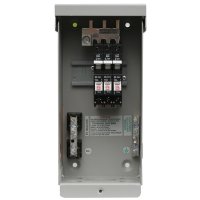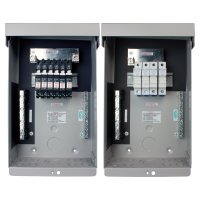
There are many types of boxes used for various functions in PV applications. This article will serve as a guide to the most commonly used ones.
In the image below, we see the PV array feeding into first a junction box, then a combiner box, then ultimately to the inverter and on to the AC load center. In addition to these items, some arrays also include a pass through box.

The junction box (or j-box) is not specific to the PV industry and can generally be easily sourced at local electrical supply or home improvement stores. This item allows the transition from exposed wire (such as PV wire or USE-2) to conduit (containing THHN/THWN). This is the sole function of a junction box.
A pass through serves two purposes: it allows for the transition to conduit (if not already provided by a junction box) and provides overcurrent protection (fuses or circuit breakers).
A combiner box is specific to the PV industry and serves three purposes: transition to conduit (if not provided by a j-box or pass-through box), overcurrent protection (OCPD), and combining the strings into parallel.
Depending on the needs of the site, a given PV array can use any combination of junction boxes, pass through boxes, and combiner boxes.
Beyond combiner boxes, some very large arrays require re-combiners. These are essentially “combiners of combiners.” They take the already joined inputs from a combiner and further combine them, so that they may be more easily inputted into a subcombiner.
The subcombiner, the king of all the PV boxes, is the last stop in the road. This is generally part of a central inverter and combines all the inputs of a large PV array to feed into the inverter to be converted to AC.
Please refer to the second image for a visual depiction of the relationship between combiners, re-combiners, and sub combiners.


